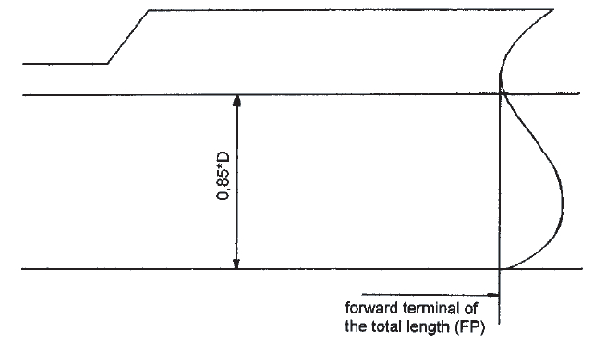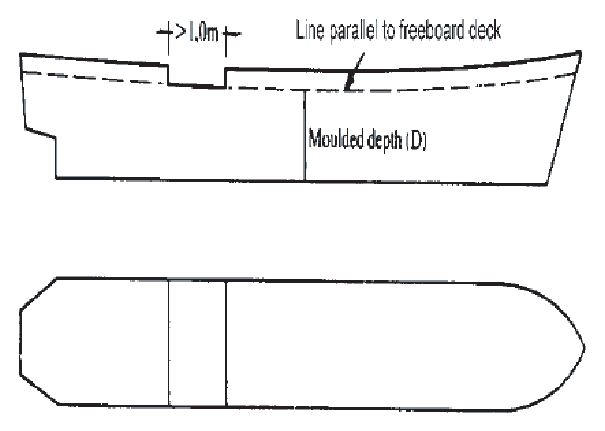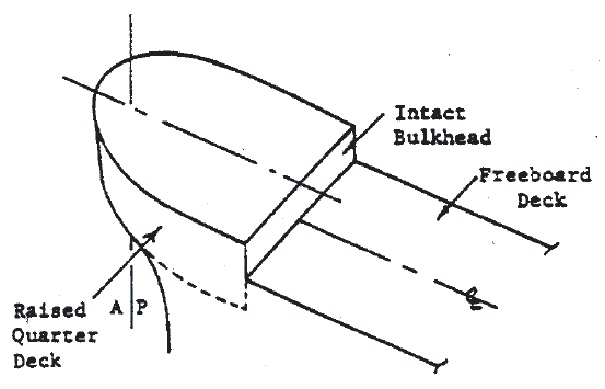(1)
Length
-
(a) The length (L) shall be taken as 96% of the
total length on a waterline at 85% of the least moulded depth measured
from the top of the keel, or as the length from the fore side of the
stem to the axis of the rudder stock on that waterline, if that be
greater.
-
(b) For ships without a rudder stock, the length
(L) is to be taken as 96% of the waterline at 85% of the least moulded
depth.
-
(c) Where the stem contour is concave above the
waterline at 85% of the least moulded depth, both the forward terminal
of the total length and the fore-side of the stem respectively shall
be taken at the vertical projection to that waterline of the aftermost
point of the stem contour (above that waterline) (see figure 3.1).
-
(d) In ships designed with a rake of keel the
waterline on which this length is measured shall be parallel to the
designed waterline at 85% of the least moulded depth Dmin,
found by drawing a line parallel to the keel line of the vessel (including
skeg) tangent to the moulded sheer line of the freeboard deck. The
least moulded depth is the vertical distance measured from the top
of the keel to the top of the freeboard deck beam at side at the point
of tangency (see figure 3.2).

Figure 3.1
Figure 3.2
(2)
Perpendiculars.
The forward and after perpendiculars shall be taken at the forward
and after ends of the length (L). The forward perpendicular shall
coincide with the foreside of the stem on the waterline on which the
length is measured.
(3)
Amidships.
Amidships is at the middle of the length (L).
(4)
Breadth.
Unless expressly provided otherwise, the breadth (B) is the
maximum breadth of the ship, measured amidships to the moulded line
of the frame in a ship with a metal shell and to the outer surface
of the hull in a ship with a shell of any other material.
(5)
Moulded depth
-
(a) The moulded depth is the vertical distance
measured from the top of the keel to the top of the freeboard deck
beam at side. In wood and composite ships the distance is measured
from the lower edge of the keel rabbet. Where the form at the lower
part of the midship section is of a hollow character, or where thick
garboards are fitted, the distance is measured from the point where
the line of the flat of the bottom continued inwards cuts the side
of the keel.
-
(b) In ships having rounded gunwales, the moulded
depth shall be measured to the point of intersection of the moulded
lines of deck and sides, the lines extending as though the gunwale
were of angular design.
-
(c) Where the freeboard deck is stepped and the
raised part of the deck extends over the point at which the moulded
depth is to be determined, the moulded depth shall be measured to
a line of reference extending from the lower part of the deck along
a line parallel with the raised part.
(6)
Depth for freeboard (D)
-
(a) The depth for freeboard (D) is the moulded
depth amidships, plus the freeboard deck thickness at side.
-
(b) The depth for freeboard (D) in a ship having
a rounded gunwale with a radius greater than 4% of the breadth (B)
or having topsides of unusual form is the depth for freeboard of a
ship having a midship section with vertical topsides and with the
same round of beam and area of topside section equal to that provided
by the actual midship section.
(7)
Block coefficient
-
(a) The block coefficient (Cb
)
is given by:
- where
|
∇ |
= |
is the volume of the moulded
displacement of the ship, excluding appendages, in a ship with a metal
shell, and is the volume of displacement to the outer surface of the
hull in a ship with a shell of any other material, both taken at a
moulded draught of d1; and where
|
|
d
1
|
= |
is 85%
of the least moulded depth. |
-
(b) When calculating the block coefficient of
a multi-hull craft, the full breadth (B) as defined in paragraph (4)
is to be used and not the breadth of a single hull.
The freeboard assigned is the distance measured vertically
downwards amidships from the upper edge of the deck line to the upper
edge of the related load line.
(9)
Freeboard deck.
-
(a) The freeboard deck is normally the uppermost
complete deck exposed to weather and sea, which has permanent means
of closing all openings in the weather part thereof, and below which
all openings in the sides of the ship are fitted with permanent means
of watertight closing.
-
(b) Lower deck as a freeboard deck
-
At the option of the owner and subject to the approval of
the Administration, a lower deck may be designated as the freeboard
deck provided it is a complete and permanent deck continuous in a
fore and aft direction at least between the machinery space and peak
bulkheads and continuous athwartships.
-
(i) When this lower deck is stepped the lowest
line of the deck and the continuation of that line parallel to the
upper part of the deck is taken as the freeboard deck.
-
(ii) When a lower deck is designated as the freeboard
deck, that part of the hull which extends above the freeboard deck
is treated as a superstructure so far as concerns the application
of the conditions of assignment and the calculation of freeboard.
It is from this deck that the freeboard is calculated.
-
(iii) When a lower deck is designated as the freeboard
deck, such deck as a minimum shall consist of suitably framed stringers
at the ship sides and transversely at each watertight bulkhead which
extends to the upper deck, within cargo spaces. The width of these
stringers shall not be less than can be conveniently fitted having
regard to the structure and the operation of the ship. Any arrangement
of stringers shall be such that structural requirement can also be
met.
-
(c) Discontinuous freeboard deck, stepped freeboard
deck.
-
(i) Where a recess in the freeboard deck extends
to the sides of the ship and is in excess of one metre in length,
the lowest line of the exposed deck and the continuation of that line
parallel to the upper part of the deck is taken as the freeboard deck
(see figure 3.3).
-
(ii) Where a recess in the freeboard deck does
not extend to the sides of the ship, the upper part of the deck is
taken as the freeboard deck.
-
(iii) Recesses not extending from side to side
in a deck below the exposed deck, designated as the freeboard deck,
may be disregarded, provided all openings in the weather deck are
fitted with weathertight closing appliances.
-
(iv) Due regard shall be given to the drainage
of exposed recesses and to free surface effects on stability.
-
(v) Provisions of subparagraphs (i) through (iv)
are not intended to apply to dredgers, hopper barges or other similar
types of ships with large open holds, where each case requires individual
consideration.

Figure 3.3
(10)
Superstructure
-
(a) A superstructure is a decked structure on
the freeboard deck, extending from side to side of the ship or with
the side plating not being inboard of the shell plating more than
4% of the breadth (B).
-
(b) An enclosed superstructure is a superstructure
with:
-
(i) enclosing bulkheads of efficient construction;
-
(ii) access openings, if any, in these bulkheads
fitted with doors complying with the requirements of regulation 12;
-
(iii) all other openings in sides or ends of the
superstructure fitted with efficient weathertight means of closing.
-
A bridge or poop shall not be regarded as enclosed unless
access is provided for the crew starting from any point on the uppermost
complete exposed deck or higher to reach machinery and other working
spaces inside these superstructures by alternative means which are
available at all times when bulkhead openings are closed.
-
(c) The height of a superstructure is the least
vertical height measured at side from the top of the superstructure
deck beams to the top of the freeboard deck beams.
-
(d) The length of a superstructure (S) is the
mean length of the part of the superstructure which lies within the
length (L).
-
(e) Bridge. A bridge is a superstructure which
does not extend to either the forward or after perpendicular.
-
(f) Poop. A poop is a superstructure which extends
from the after perpendicular forward to a point which is aft of the
forward perpendicular. The poop may originate from a point aft of
the aft perpendicular.
-
(g) Forecastle. A forecastle is a superstructure
which extends from the forward perpendicular aft to a point which
is forward of the after perpendicular. The forecastle may originate
from a point forward of the forward perpendicular.
-
(h) Full superstructure. A full superstructure
is a superstructure which, as a minimum, extends from the forward
to the after perpendicular.
-
(i) Raised quarterdeck. A raised quarterdeck is
a superstructure which extends forward from the after perpendicular,
generally has a height less than a normal superstructure, and has
an intact front bulkhead (sidescuttles of the non-opening type fitted
with efficient deadlights and bolted man-hole covers) (see figure 3.4). Where the forward bulkhead is
not intact due to doors and access openings, the superstructure is
then to be considered as a poop.

Figure 3.4
(11)
Superstructure deck.
A superstructure deck is a deck forming the upper boundary
of a superstructure.
A flush deck ship is one which has no superstructure on
the freeboard deck.
Weathertight means that in any sea conditions water will
not penetrate into the ship.
Watertight means capable of preventing the passage of water
through the structure in either direction with a proper margin of
resistance under the pressure due to the maximum head of water which
it might have to sustain.
A well is any area on the deck exposed to the weather, where
water may be entrapped. Wells are considered to be deck areas bounded
on two or more sides by deck structures.
(16)
2008 IS Code means
the International Code on Intact Stability, 2008, consisting of an
introduction, part A (the provisions of which shall be treated as
mandatory) and part B (the provisions of which shall be treated as
recommendatory), as adopted by resolution
MSC.267(85), provided that:
-
.1 amendments to the introduction and part A of
the Code are adopted, brought into force and take effect in accordance
with the provisions of article VI of
the 1988 Load Lines Protocol concerning the amendment procedure applicable
to Annex B to the Protocol; and
-
.2 amendments to part B of the Code are adopted
by the Maritime Safety Committee in accordance with its Rules of Procedure.
(17)
Audit means a systematic, independent and documented process for obtaining audit
evidence and evaluating it objectively to determine the extent to which audit criteria
are fulfilled.
(18)
Audit Scheme means the IMO Member State Audit Scheme established by the
Organization and taking into account the guidelines developed by the Organizationfootnote.
(19)
Code for Implementation means the IMO Instruments Implementation Code (III Code)
adopted by the Organization by resolution A.1070(28).
(20)
Audit Standard means the Code for Implementation.